March 27, 2009
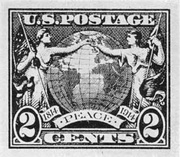
This article focuses on essays (stamps that were designed but never issued), describing various designs and noting some of the ways the government tried to prevent stamp reuse in the late 1800s. It originally appeared in the December 1943 issue of American Collector magazine, a publication which ran from 1933-1948 and served antique collectors and dealers.
It was a shock to the Bureau of Engraving and Printing when a critic pointed out that the view of “Gatun … (continue reading)
March 26, 2009
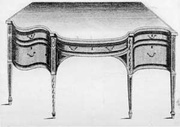
This article focuses on the history of the sideboard table, noting its functions, varying designs, notable craftsmen, and the man who developed the first sideboard table, Thomas Shearer. It originally appeared in the July 1941 issue of American Collector magazine, a publication which ran from 1933-1948 and served antique collectors and dealers.
The early sideboard was more than a decorative piece of dining-room furniture. Functionally, it was the 18th-Century version of the modern serving pantry. In an … (continue reading)

This article describes sterling silver items (such as punch bowls and tankards) popular in New York in the late 18th and 19th centuries, noting their strong Dutch influences and the evolution of the design styles. It originally appeared in the October 1947 Special Sunnyside Edition of American Collector magazine, a publication which ran from 1933-1948 and served antique collectors and dealers.
In 1800 when Washington Irving, son of a Scottish born New York merchant, made his first … (continue reading)
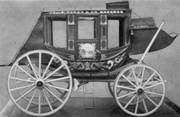
This article on Wells Fargo stagecoaches gives a brief history and describes the way they were decorated. It originally appeared in the September 1941 issue of American Collector magazine, a publication which ran from 1933-1948 and served antique collectors and dealers.
The desire to have a model of an old-time Wells Fargo coach for my own collection of the railroads and other means of transportation at Pittsford, New York, came as a swift inspiration, rather than a long … (continue reading)
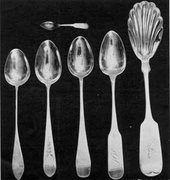
This article discusses the social significance of the silver spoon throughout history and the different types of silver spoons made from the 12th through the 19th centuries. It originally appeared in the July 1941 issue of American Collector magazine, a publication which ran from 1933-1948 and served antique collectors and dealers.
From the Middle Ages down, the silver spoon has been a symbol of a certain standard of living. “Born with a silver spoon in his mouth” … (continue reading)
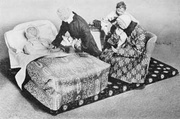
This article discusses the use of dolls in models of historic events or locations, noting a display representing George Washington’s death as an example. It originally appeared in the July 1941 issue of American Collector magazine, a publication which ran from 1933-1948 and served antique collectors and dealers.
About a quarter of a century ago habitant groups and small-scale models of historic events and places appeared in our museums and similar public places. It was considered a most modern … (continue reading)
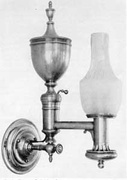
This article describes the history of the oil lamp, noting its evolution from Betty lamps to the Argand burner to a lamp with an oil reservoir in the base. It originally appeared in the September 1941 issue of American Collector magazine, a publication which ran from 1933-1948 and served antique collectors and dealers.
Among old-time lamps there are certain types that mark changes in the manner of living or that are representative of classes or occupations. Others … (continue reading)
March 20, 2009
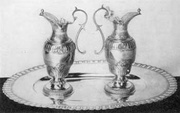
This article focuses on the French and later British influences on Canadian silver in the 18th and 19th centuries, noting important silversmiths and the spread of silver production from Quebec to Montreal. It originally appeared in the February 1941 issue of American Collector magazine, a publication which ran from 1933-1948 and served antique collectors and dealers.
The silver crosses discovered in the past hundred years in old Indian graves from Georgia to Wisconsin and Ontario are all of … (continue reading)
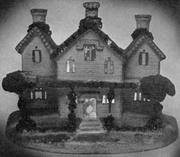
This article discusses American folk art figurines, which were made one-at-a-time by local individuals as opposed to being mass-produced by a factory like other figurines. It notes the various influences on the figurines’ designs and the production process. It originally appeared in the January 1941 issue of American Collector magazine, a publication which ran from 1933-1948 and served antique collectors and dealers.
Decoration for the simple farmhouse or the village-dwelling artisan’s cottage in all countries began and generally … (continue reading)
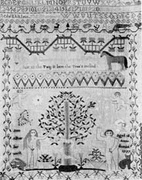
This article discusses the history of samplers, which young girls were often required to work on daily in the 18th and early 19th centuries. It notes the evolution of the sampler from pieces of cloth with samples of various patterns to an elaborate expression of the sewer’s skill with a needle. It originally appeared in the April 1942 issue of American Collector magazine, a publication which ran from 1933-1948 and served antique collectors and dealers.
In one of … (continue reading)
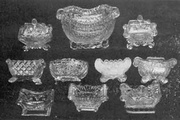
This article notes the various designs and manufacturers of salt dishes, noting the slight differences between similar-looking items created by competing companies. It originally appeared in the June 1939 issue of American Collector magazine, a publication which ran from 1933-1948 and served antique collectors and dealers.
Greater variety of form and decoration are to be found in salt cellars than in any other piece of tableware made by American glassworkers. Over a thousand different designs are known … (continue reading)
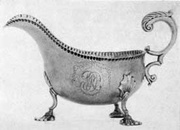
This article notes the four major families that produced silver in 18th-century Boston (The Edwards, Reveres, Hurds, and Burts), focusing primarily on the lives and crafts of John and Benjamin Burt. It originally appeared in the August 1940 issue of American Collector magazine, a publication which ran from 1933-1948 and served antique collectors and dealers.
According to present-day standards, 18th-Century Boston was never more than a good-sized village. In 1700, it had an estimated population of 7,000; … (continue reading)
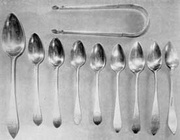
This article focuses on silversmith Samuel Drowne and his involvement in the American Revolution and U.S. politics. It also provides information on the other silversmiths in his family. It originally appeared in the September 1940 issue of American Collector magazine, a publication which ran from 1933-1948 and served antique collectors and dealers.
Undoubtedly the name of Samuel Drowne is as well known as that of any of the early silversmiths of Portsmouth, N. H., but locally, at least, … (continue reading)
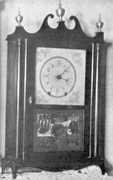
This article describes the skill involved in the craft of miniature clockmaking, as well as the different types of miniature clocks (grandfather, grandmother, and grandchild), how each is made, and some of the notable manufacturers. It originally appeared in the January 1939 issue of American Collector magazine, a publication which ran from 1933-1948 and served antique collectors and dealers.
The true miniature antique clock of whatever land, is characterized by fineness of conception and skillful … (continue reading)
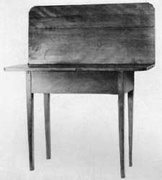
This article notes the various woods cabinetmakers have used, such as oak, mahogany, maple, and cherry, and argues that birch is comparable in quality and should be equally as desirable. It notes the limited locations in which birch was used and the wide variety of items that were crafted from the material, from clocks to tables to plates. It originally appeared in the November 1940 issue of American Collector magazine, a publication which ran from 1933-1948 and … (continue reading)















 It Came From the '70s: The Story of Your Grandma's Weird Couch
It Came From the '70s: The Story of Your Grandma's Weird Couch My Little Pony Smackdown: Girls vs. Bronies
My Little Pony Smackdown: Girls vs. Bronies Michael Jackson's Iconic Glove
Michael Jackson's Iconic Glove From Ruby Slippers to Kermit the Frog: Pop Culture Artifacts at the Smithsonian
From Ruby Slippers to Kermit the Frog: Pop Culture Artifacts at the Smithsonian The Mystery of the Phantom Page Turner
The Mystery of the Phantom Page Turner Mari Tepper: Laying it on the Line
Mari Tepper: Laying it on the Line Nice Ice: Valerie Hammond on the Genteel Charm of Vintage Canadian Costume Jewelry
Nice Ice: Valerie Hammond on the Genteel Charm of Vintage Canadian Costume Jewelry How Jim Heimann Got Crazy for California Architecture
How Jim Heimann Got Crazy for California Architecture Modernist Man: Jock Peters May Be the Most Influential Architect You've Never Heard Of
Modernist Man: Jock Peters May Be the Most Influential Architect You've Never Heard Of Meet Cute: Were Kokeshi Dolls the Models for Hello Kitty, Pokemon, and Be@rbrick?
Meet Cute: Were Kokeshi Dolls the Models for Hello Kitty, Pokemon, and Be@rbrick? When the King of Comedy Posters Set His Surreal Sights on the World of Rock 'n' Roll
When the King of Comedy Posters Set His Surreal Sights on the World of Rock 'n' Roll How One Artist Makes New Art From Old Coloring Books and Found Photos
How One Artist Makes New Art From Old Coloring Books and Found Photos Say Cheese! How Bad Photography Has Changed Our Definition of Good Pictures
Say Cheese! How Bad Photography Has Changed Our Definition of Good Pictures Middle Earthenware: One Family's Quest to Reclaim Its Place in British Pottery History
Middle Earthenware: One Family's Quest to Reclaim Its Place in British Pottery History Fancy Fowl: How an Evil Sea Captain and a Beloved Queen Made the World Crave KFC
Fancy Fowl: How an Evil Sea Captain and a Beloved Queen Made the World Crave KFC